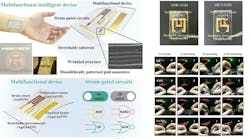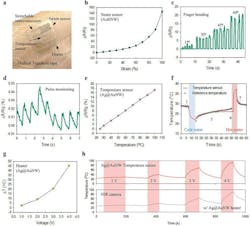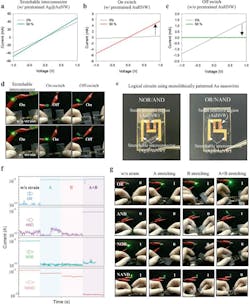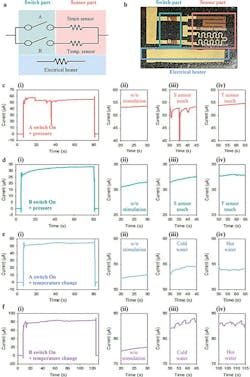What you’ll learn:
- What are the challenges for real-time biosensing and “edge” analysis?
- How do gold and gold-silver nanowires address the issue?
- How these sensors can implement elementary logic functions.
Wearable electronics and biosensors that can monitor health and provide real-time data and even analysis are seen as the future of personalized medicine. There’s certainly been lots of progress in this area, ranging from smartwatches to specialized skin patches. Nonetheless, while wearable watches increasingly do some analysis at the “edge,” most of today’s patch-like wearables collect raw data to be processed later.
Addressing this issue, researchers in the Department of Materials Science and Engineering at South Korea’s Pohang University of Science and Technology (POSTECH) developed stretchable, multifunctional circuits made from nanowire structures of gold and other metals (Fig. 1). These circuits can both sense health signals directly on the skin and process that data in real-time without external algorithms or rigid chips.
Going for the Gold
These nanowires are more than just ultra-thin wires. The team began by developing bulk gold nanowires by coating the exterior of the silver nanowires, suppressing the inherent galvanic phenomenon. Subsequently, they created hollow gold nanowires by selectively etching the silver from the gold-coated nanowires (Fig. 2).
Using a combination of galvanic growth and selective etching, the team developed techniques to synthesize and pattern both hollow gold nanowires as well as hollow gold ones filled with silver.
This yielded gold nanowires in both hollow and filled forms. The filled gold-silver core-shell nanowires provided high conductivity with lower sensitivity to strain while the hollow gold nanowires were more strain sensitive but less conductive.
Building a Multifunctional Sensing Platform
By integrating both nanowire types into monolithic circuits, the team created a multifunctional platform able to sense temperature, strain, and other signals while also performing logical operations (Fig. 3). The filled gold nanowires served as interconnects and temperature sensors, while the hollow gold nanowires function as strain gauges.
Key to the seamless integration of diverse components was the use of a monolithic nanowire patterning technique. This overcame integration challenges that have long constrained multifunctional wearables, such as mechanical failures at interfaces between materials with mismatched properties, which has been a long-standing problem. However, by combining compatible nanowire types into single-structure circuits, they were able to minimize these concerns.
In addition, by adjusting the nanowire geometry, they were able to implement strain-gated switches where strain either increased or decreased electrical conductivity (Fig. 4). By connecting these switches, they were able to construct basic logic circuits performing AND, OR, NAND, and NOR operations. The researchers used these circuits to demonstrate capabilities like activating sensors and routing their signals for further processing.
Chemically Stable and Stretchable
Compared to pure silver or copper nanowire alternatives, the gold composite structures also provided much higher chemical stability for biomedical uses. Further, unlike attempts to incorporate silicon chips, all components remained fully stretchable as they twisted and deformed without damage on the stretchable, flexible biocompatible substrate to which they were attached (Fig. 5).
Although the actual applications for such multivariable sensing and logic patches may seem esoteric, project co-leader Dr. Sei Kwang Hahn noted that their platform has many potential applications. Among these are a smart wound dressing that monitors strain on a healing injury, where it could detect excessive swelling and automatically heat the area to stimulate healing. Another possibility is a smart contact lens that monitors ocular strain and provides cues when it’s time to blink and prevent dryness.
The work is described in their 13-page paper “Multifunctional Intelligent Wearable Devices Using Logical Circuits of Monolithic Gold Nanowires” published in Advanced Materials. They have also provided a detailed Supplementary Information file posting.


![2. Characteristics of gold nanowires: (a) Schematic illustration for the preparation of Ag@AuNW and AuHNW. (b) UV-vis absorbance of silver nanowires, Ag@AuNWs, and AuHNWs. [NW: nanowire, HNW: hollow nanowire] 2. Characteristics of gold nanowires: (a) Schematic illustration for the preparation of Ag@AuNW and AuHNW. (b) UV-vis absorbance of silver nanowires, Ag@AuNWs, and AuHNWs. [NW: nanowire, HNW: hollow nanowire]](https://img.electronicdesign.com/files/base/ebm/electronicdesign/image/2024/01/65a9312cb05afd001e321877-ed_biosensornanowires_interest_fig2.png?auto=format,compress&fit=max&q=45&h=85&height=85&w=250&width=250)


